
Anatomy Etymology by Visible Body
- 1. What’s the word? A look at the etymology of anatomy.
- 2. Etymology, or the study of word origins and their changes throughout history, can be like a very weird game of telephone. A word may start out as one thing and centuries later wind up becoming something completely different, or it may stay the course from the moment of its inception. To really drive this point home, we’ve rounded up 18 anatomy terms, their meanings, and their origins. Some of them may surprise you!
- 3. Key Terms and Symbols Not everyone is in-the-know when it comes to etymology, so here are some things you may encounter in this eBook: PIE: Many of these words have derived from Proto-Indo-European (PIE), the hypothetical reconstructed ancestral language of the Indo-European family.The most recent date proposed for it is about 5,500 years ago. Sorry to any sweets lovers who thought we were talking about actual pie. Cognate: These are words that have a common etymological origin as another word. For example, the English word is (German ist, Latin est, Indo-European esti). *: In etymology, an asterisk indicates that a word’s existence is not attested to by any written source, and therefore is just conjecture. All words in PIE are written with an asterisk, as there aren’t written examples of them.
- 4. Pulmonary From the French pulmonaire, derived from the Latin pulmonarius and Greek cognate pleumon Derived from PIE *pleu- “to float” Fun Fact: Animal lungs float when cooked in a pot of water, whereas animal hearts do not. It is believed the original meaning“to float”comes from this notion.
- 5. Brain Old English brægen “brain,” from Proto-Germanic *bragnam, from PIE root *mregh-m(n)o- “skull, brain” An earlier PIE word, *bhragno, means “something broken”
- 6. Skull Most likely from Old Norse skalli “a bald head, skull,” a general Scandinavian word (compare to the Swedish skulle) Probably also related to Old English scealu, “husk”
- 7. Liver Old English lifer, from Proto-Germanic *librn, perhaps from PIE *leip-“to stick, adhere; fat” Fun Fact: People used to believe the liver produced blood. In medieval times, it rivaled the heart as the supposed seat of love and passion. This is where the term“lily-livered”comes from!
- 8. Muscle From the Middle French muscle “muscle, sinew” and directly from Latin musculus “a muscle,” literally“little mouse” Fun Fact:The shape and movement of some muscles, particularly the biceps, were thought to resemble little mice under the skin, hence“little mouse.”
- 9. Artery From 14th century Anglo-French arterie, Old French artaire (Modern French artère), and directly from Greek arteria “windpipe” Fun Fact: Because arteries do not contain blood after death, in ancient times they were believed to be filled with air.
- 10. Nerve From Old French nerf and from Latin nervus “sinew, tendon; cord, bowstring” Also from PIE *(s)neu- “tendon, sinew” and cognate Greek neuron “sinew, tendon” Fun Fact:The meaning of“sinew”also has a secondary notion: that of strength or vigor.This is where having the“nerve”to do something comes from.
- 11. Lymph From the French lymphe, from Latin lympha “water, clear water, a goddess of water,” altered by the influence of Greek nymphe “goddess of a spring, nymph” Fun Fact:The word“lymph”was first used in a physiological sense in 1725. However, it was used earlier in English in the classical sense for“pure water”(1620s) and also in reference to colorless fluids in plants (1670s).
- 12. Sacrum From the late Latin os sacrum “sacred bone,” from Latin os“bone”and sacrum “sacred” Fun Fact:The sacrum was often the bone offered in animal sacrifices, hence“sacred.”
- 13. Larynx From Middle French larynx, from Greek larynx (laryngos)“the upper windpipe”
- 14. Vertebra From Latin vertebra“joint or articulation of the body, joint of the spine,” perhaps from vertere “to turn” Fun Fact:The notion of“to turn”came from the idea that the spine was the“hinge” of the body.
- 15. Dura mater From Medieval Latin dura mater cerebri “hard mother of the brain,” a loan- translation of Arabic umm al-dimagh as-safiqa “thick mother of the brain” Fun Fact:The words“father,” “mother,” and“son”are often used to denote relationships between things in Arabic.
- 16. Thyroid From Greek thyreoiedes “shield-shaped” (in khondros thyreoiedes “shield-shaped cartilage,” used by Greek philosopher and surgeon Galen to describe the Adam’s apple), from thyreos“oblong, door-shaped shield”
- 17. Heart Old English heorte“heart; breast, soul, spirit, will, desire; courage; intellect,” from Proto- Germanic *herton-, from PIE *kerd-“heart” Fun Fact:The Greek cognate of *kerd- is kardia, which is where the root word cardio- originates.
- 18. Tooth Old English toð, from Proto-Germanic *tan-thuz, from PIE *dent- “tooth” (cognates include Greek odontos, Latin dens) Fun Fact:The Greek and Latin cognates of *dent- can be found in such words as“orthodontist” and“dentition.”
- 19. Kidney Of unknown origin, originally kidenere, perhaps a compound of Old English cwið “womb”+ey “egg,” inreferencetotheshape of the organ
- 21. Finger Old English finger, fingor “finger,” from Proto-Germanic *fingraz, with no cognates outside Germanic Fun Fact: It is thought that the word is connected with PIE *penkwe-, the root meaning“five.”
- 22. GRATITUDE From Middle French gratitude, from Latin gratus “thankful, pleasing” Thanks for an amazing year. See you in 2015!
